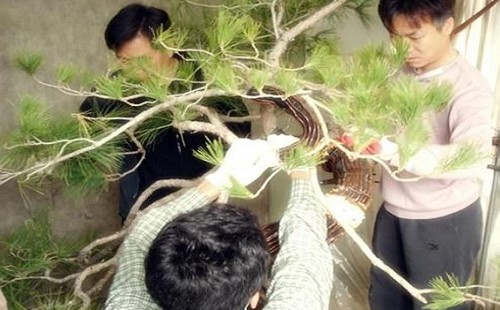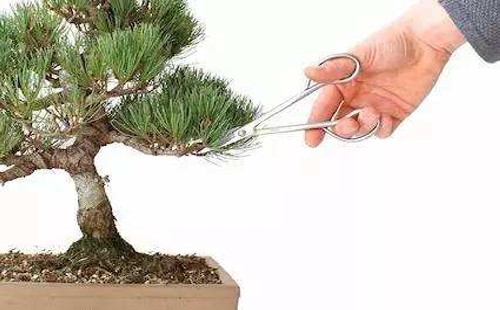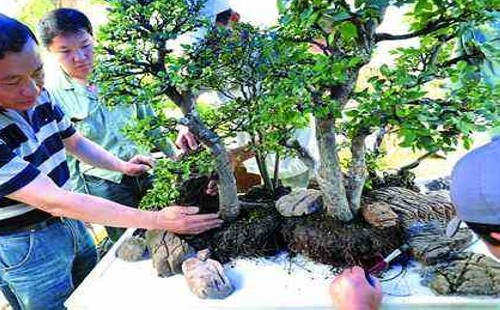The method of bending the branches of Elm Bonsai
Taking the bend is a modeling method often used in the creation of bonsai works, and we need to master certain skills before the operation, otherwise it may lead to the failure of the bend and cause loss to the branches. thus weakening the tree potential will also affect the embodiment of ornamental value. Many people always break branches because they do not master the basic bending skills.

Elm bonsai is often used to take the bend in the process of creation, and the bend usually needs the help of wire to change the direction of the branches, and the distribution of branches is more reasonable, which is very important for the modeling effect of bonsai. The most commonly used wire for bending is aluminum wire. So, how do elm bonsai bend the branches? Next, the editor will share with you how to bend the branches of elm bonsai.
Usually, the thickness of aluminum wire is about 1 big and 3 thick branches. Because the toughness of the branch should be proportional to the toughness of the aluminum wire, and when binding, it is necessary to keep the aluminum wire close to the outer skin of the branch, so that the branch can be better distributed, so as to achieve the effect of shaping.
At the same time, when the aluminum wire is wound at the point to be fixed, it should be done at an angle of 45 degrees. That is, according to this angle, the beveled aluminum wire is tied to the branch, forming a 45-degree angle with the branch, so that the upper and lower point of effort can be more balanced, and it is not easy to break the branch or hurt the outer skin of the branch too much. the degree of branch damage can be reduced to a minimum.
And in the process of binding and bending, it is suggested that the double aluminum wire should be wound in the same direction, especially where there is a bifurcation starting point, the appropriate support point or focus point must be selected, and the direction of winding aluminum wire should be kept in the same direction with the bound aluminum wire. as far as possible, there will be no interweaving and overlap between aluminum wire and aluminum wire. And when winding aluminum wire, we should keep it close to the outer skin of the branch as much as possible, and the external force exerted should not be borne entirely by the branch to avoid causing excessive damage to the branch, so we should find multiple focal points to disperse the role of external force. even let the hand bear part of the external force when necessary.
In the process of bending the branches, especially after winding the aluminum wire on the branches, we must adjust the direction and curvature of the branches along the winding direction of the aluminum wire. And when adjusting the curvature of the branch, one hand should firmly hold on to the bifurcation of the bent branch to prevent the branch from being torn. And when the bending operation is carried out when looking for the strength point or support point along the direction of the aluminum wire, the outer skin of the branch should be pinched or gently rubbed in advance, so that the branch has a certain degree of flexibility before implementation, which can effectively avoid the phenomenon of branch breaking or fracture.
Time: 2019-06-07 Click:
- Prev

When and how to trim the pine bonsai
Pine bonsai is a common variety in bonsai art creation, but it often shows people a positive spirit with its elegant image and upright temperament. It is precisely because the pine tree's perfect external image is combined with its tenacious inner temperament to give full play to its own advantages.
- Next

How short are the branches of elm bonsai
Elm is a kind of deciduous tree, generally, whether it is the daily maintenance management or the modeling of bonsai, usually by means of pruning. The main purpose of the pruning of elm bonsai is to shape a good plant type, so we can't just focus on pruning, and we should properly consider keeping branches in the process of pruning.
Related
- Fuxing push coffee new agricultural production and marketing class: lack of small-scale processing plants
- Jujube rice field leisure farm deep ploughing Yilan for five years to create a space for organic food and play
- Nongyu Farm-A trial of organic papaya for brave women with advanced technology
- Four points for attention in the prevention and control of diseases and insect pests of edible fungi
- How to add nutrient solution to Edible Fungi
- Is there any good way to control edible fungus mites?
- Open Inoculation Technology of Edible Fungi
- Is there any clever way to use fertilizer for edible fungus in winter?
- What agents are used to kill the pathogens of edible fungi in the mushroom shed?
- Rapid drying of Edible Fungi

